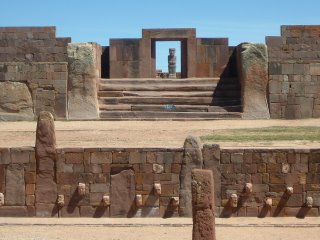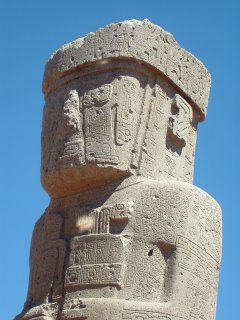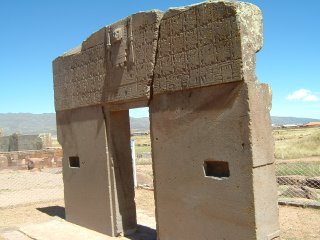 Tiwanaku. A civilization which ended at least 200 years before the Incas existed. That's pretty mindblowing. Unfortunately, the Tiwanaku ceremonial site has been so looted over the years that we don't know much about them. (In fact, the nearby town church was built using many of the stones from the ruins). Luckily, new discoveries are made every year -- I think just last year, they realized that there were mummies underground and a whole maze of tunnels and tombs.
Tiwanaku. A civilization which ended at least 200 years before the Incas existed. That's pretty mindblowing. Unfortunately, the Tiwanaku ceremonial site has been so looted over the years that we don't know much about them. (In fact, the nearby town church was built using many of the stones from the ruins). Luckily, new discoveries are made every year -- I think just last year, they realized that there were mummies underground and a whole maze of tunnels and tombs.Speaking of tunnels, I needed one as I attempted to catch the tourist bus to Tiwanaku. The morning had started off relatively well - I managed to wake up on time after the late night wedding party, had hopped into a cab, and was enjoying a nice chat with driver when we kept getting diverted by the traffic cops. Come to find out that of all the 365 mornings of the year, the morning of April 22, 2006 just happened to be the day of the biggest marathon in La Paz. Go figure. Naturally, the marathon course followed the one main road of La Paz and, naturally, that was the one road that I needed to cross to get to the bus. With three minutes before departure, I hastily called the tourist company, who told me that the bus wouldn't leave until 8:30 and that I should proceed to the storefront.

After frantically searching for a tunnel to cross under the road, I gave up and just crossed the road when there was a break in runners. I don't think the police saw me. I finally arrived at the storefront, where Luisa was waiting for me -- not to walk me to the bus but to tell me her life story, which included working as a maid for the American Embassy, being wrongfully accused of stealing, getting married, and becoming a tourist company agent. After this 45-minute chat with Luisa, a woman named Lucy appeared, who walked me to where Isabel was standing, who walked me to the bus, which was filled with tourists who had been waiting 45 minutes for me. Typical Bolivian communication breakdown. And don't even ask why it took three different women to get me to the bus.
We finally got on the road and I made nice with the other folks, who were from Ecuador, Germany, France, Belgium, Holland, England and Australia. And they had all been traveling for at least 2 weeks, with 3-7 more weeks ahead of them. I was green with envy. The French woman was also green, but with a stomach bug that forced us to pull over while she vomited. That earned her the title of "most-hated tourist on the bus" instead of me. Was it bad of me to think that?
 Anyway, the ruins themselves aren't actually much to look at right now. There are some impressive monoliths (above) and the incredible carved Gateway of the Sun (left) made of one single stone, but it's nothing like Machu Picchu (or so I've heard. Haven't made it there in person yet). That's about it. Still, having been built between the 4th and 8th century AD, Tiwanaku makes your imagination run wild -- how did these people transport 25-ton stone blocks, which had to have come from either Lake Titicaca (40km away) or the nearest sandstone site (5km away)? And how did they figure out that the site of the Akapana pyramid is equidistant from the two highest mountains in the distance? How did they build the Kalasasaya temple so that the sun's rays would would cut through it diagonally and perpendicularly on the solstices and equinoxes? Just amazing, thrilling, and magical stuff.
Anyway, the ruins themselves aren't actually much to look at right now. There are some impressive monoliths (above) and the incredible carved Gateway of the Sun (left) made of one single stone, but it's nothing like Machu Picchu (or so I've heard. Haven't made it there in person yet). That's about it. Still, having been built between the 4th and 8th century AD, Tiwanaku makes your imagination run wild -- how did these people transport 25-ton stone blocks, which had to have come from either Lake Titicaca (40km away) or the nearest sandstone site (5km away)? And how did they figure out that the site of the Akapana pyramid is equidistant from the two highest mountains in the distance? How did they build the Kalasasaya temple so that the sun's rays would would cut through it diagonally and perpendicularly on the solstices and equinoxes? Just amazing, thrilling, and magical stuff.We stopped for lunch at a local restaurant, where I ordered the fish because I didn't have enough nerve to order the llama. But the nice Swiss man offered me a bite of his llama lunch. It was delicious, and evidently is much healthier for you than any other meat.
We arrived back in La Paz about 45 minutes later than scheduled.

2 comments:
Again with the nice photos. Great stuff.
I'm a big fan of ruins and what they meant to the people that lived there. I've been to a few in Mexico and those at Tiwanaku are similar in style. It's kind of ironic that we see ourselves as so much more advanced and yet we are befuddled when we see something that shouldn't have been possible. Humbling really, isn't it?
Funny you should mention the significance of the ruins to the local people. Our guide was Aymara, who are descendants of the original Tiwanku. She asked our group more than once to reach beyond intellectual understanding and feel the energy of the site. Your imagination can let loose at a place like that!
And you're right -- the immensity of those ancient accomplishments not only dizzies the mind, but humbles and touches the heart.
Post a Comment